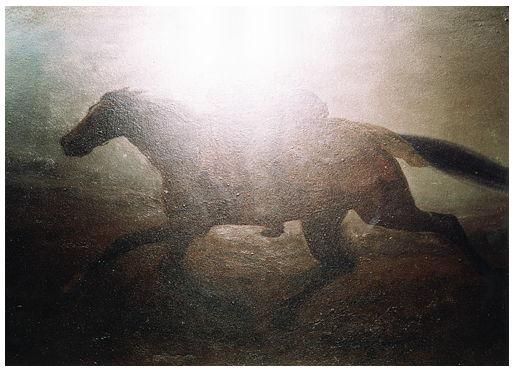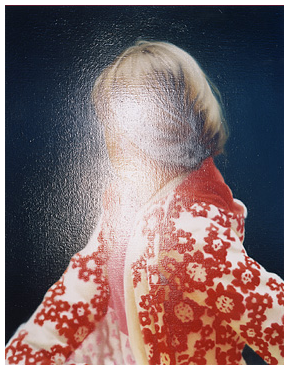Tim Davis is one of the more fascinating photographers I've found out about recently. I learned about him from Jeff Ladd's book recommendations for us, posted last August. Jeff recommended Tim's book My Life in Politics, which I still don't own. It's a curious set of pictures. It would be difficult to imagine more foursquare, nondescript photographs—they make the economical Zoe Strauss seem florid by comparison—but because the set as a whole has such a strong hand of authorship, the pictures become fascinating. But really only collectively, and presumably in sequence. I end up unsure just what, and how much, the "author" (i.e., the photographer) means, and how much of the ruminations I bring to the pictures come from me. At the very least, from a didactic standpoint, it's a fine object lesson about the authorial possibilities of pictures. You can see some at Davis's website. But be warned, the pictures don't grab; be prepared to spend some time, and to bring something to them.
"Permanent collection" is equally fascinating in that it seems like such a dull idea on its face (and of course Elliott Erwitt came and went from the same territory long ago), yet the pictures themselves evoke thoughtfulness, perhaps arising from the photographs' insistence on the paintings' corporeality.
There's a book, too, from Nazraeli, of a mere 72 pages, that seems to be slipping into unavailability.
Featured Comment by Gavin: "Just noticed that on Tim Davis's website in the 'Permanent Collection' area is a photo called 'Betty.' This is a photo of one of Gerhard Richter's paintings of his daughter, made from a photograph. The painting, unlike many of his other 'photo paintings,' is not distorted, and when you view it from a short distance looks like a photo. We seem to be going in circles."
Featured Comment by Calvin Amari: "The 'Betty' image is even more circular than suggested. The Davis photo, as noted, indeed is of a Gerhard Richter painting, which itself is derived from a photo (presumably taken by Richter himself). What sometimes is not fully apprehended is the fact that the subject, Richter's daughter, is not turned staring into space. Rather, she is looking back at one of her father's grey monochromatic paintings rather than at Richter himself. Hence the matryoshka-like nesting problem that Davis extended begins with a painting. (So far as I know, Richter's Grey Painting series, generally dating from the late '60s and early '70s, was not derived from photographs, but one can speculate about exposure problems....)"





Simple, enchanting, "no bullshit" images. And with a great, if individual, aesthetic sensibility, they won't/don't appeal to everyone but I could spend hours looking at his work.
I like the Zoe Strauss comparison as well, another person who uses simplicity to let the image talk.
Your comment about what the viewer brings is interesting, I have always thought that the viewer has as much to do with the image as the maker. And we as viewers (without getting too post modern) will always bring different things to an image (or series) that should not be underestimated.
Now, can I justify buying a book ........
Posted by: David Boyce | Wednesday, 01 April 2009 at 10:11 AM
Hi Mike,
I greatly admire your site and don't want this to be understood in the wrong way, but I don't understand the picture of this Post. It looks like a badly taken photo of an oil painting. (So much light reflecting I can't see the 'fugitive slaves') Is this the wanted artistic effect, or is it simply a bad picture?
Posted by: Christian Kurmann | Wednesday, 01 April 2009 at 10:29 AM
Perhaps it's just a matter of taste,, but the above image doesn't do anything for me. Is it just a photo of a painting, with glare from an overhead light source obscuring the rider's head?
Posted by: Jayson Merryfield | Wednesday, 01 April 2009 at 10:40 AM
If you like "Permanent Collections", then see this (not that it matters, but done long before Davis's PC)
http://www.millerprojects.com/statesmen/
Regards,
Robert
Posted by: robert harshman | Wednesday, 01 April 2009 at 12:03 PM
And a link to an interview with Sybil Miller about the Statesmen work.
http://www.millerprojects.com/statesmen/docs/interview.pdf
Regards,
Robert
Posted by: robert harshman | Wednesday, 01 April 2009 at 12:06 PM
I like it.
Posted by: charlie d | Wednesday, 01 April 2009 at 12:17 PM
I first heard about Tim Davis on Noel Rodo-Vankeulen's blog We Can't Paint. I almost bought My Life In Politics from a used book shop but it wasn't in great shape and it tuned out that it cost less new from Amazon!
Vankeulen makes an interesting point on his blog about why he dislikes most street photography while discussing why he finds Tim Davis's work so interesting
http://wecantpaint.com/log/?p=1183
Posted by: i | Wednesday, 01 April 2009 at 02:04 PM
I was interested to see the shot you include here (and others at his web site) of photographs he's taken of paintings. I've taken some nice photos of interesting artwork but I've never felt they have any value because it feels like I'm just piggybacking on other work, stealing credit from another artist. But Tim's deliberate use of carefully placed flash starts to make the artwork, the photograph his own. Interesting to think at what point such work becomes one's own. It's not unlike the reappropriation that occurs commonly in other mediums like printmaking.
Posted by: Jesse | Wednesday, 01 April 2009 at 02:30 PM
I liked some of it. I thought the hospital series was successful, and "KMart Hobby Horse" from Lots made me kind of start when I saw it- don't know why, but I really like that shot.
Posted by: jchristian | Thursday, 02 April 2009 at 12:21 PM
The photos of artworks are interesting its a bit like looking at a cascade of mirrors. I recently visited the Gerhard Richter Portraits exhibition at the National Portrait Gallery in London - They were all paintings of photographs. Richter is interested in the idea that painted portraits are more about the artist than the sitter and paints from photographs to emphasize it. Unfortunatly you weren't allowed to take photographs
Posted by: Gavin | Friday, 03 April 2009 at 08:03 AM
The Sybil Miller stuff is nice. Liked the "City Seen" images.
Posted by: David Boyce | Monday, 06 April 2009 at 12:48 AM
The two photos you show us in this article just look like mistakes to me. I've taken too many photos like that, but I don't show them to people, because they're *bad photos*.
Posted by: David Dyer-Bennet | Monday, 06 April 2009 at 03:58 PM
"I don't show them to people, because they're *bad photos*."
DD-B,
Right, and Bob Dylan can't sing. Heard it before.
What you say is exactly what was said about Robert Frank's photographs in The Americans, and innumerable other art projects that are now understood and valued. The French Impressionists were vilified hysterically, and almost nothing in painting is so adored by the public now. And so on, ad nauseam.
If an artist is trying to make a point over an extended body of thoughtful and directed work, there are a lot of responses that seem valid to me. But their resemblance to pictures that someone thinks are "bad" is not one of them.
--Mike, to whom a lot of "good" photos are "bad"
Posted by: Mike Johnston | Monday, 06 April 2009 at 05:42 PM